
|
Now it is bright as 8.3 mag (Nov. 18, Chris Wyatt). It is observable at 8 mag for a long time from 2022 to 2023. In the Southern Hemisphere, it stays observable for a long time, although it becomes low temporarily from November to December. In the Northern Hemisphere, it is not observable until 2023 summer.
Date(TT) R.A. (2000) Decl. Delta r Elong. m1 Best Time(A, h)
Nov. 19 16 45.61 -48 53.3 2.592 1.839 32 8.1 18:20 ( 44,-21)
Nov. 26 16 57.87 -51 23.6 2.580 1.822 32 8.0 18:18 ( 43,-24)
|
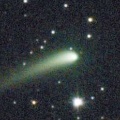
|
Now it is bright as 10.5 mag (Nov. 16, Osamu Miyazaki). It will approach to Earth down to 0.29 a.u. in 2023 February, and it is expected to brighten up to 5 mag. In the Northern Hemisphere, it stays observable in excellent condition for a long time, although it becomes extremely low temporarily in November. In the Southern Hemisphere, it is not observable until early February.
Date(TT) R.A. (2000) Decl. Delta r Elong. m1 Best Time(A, h)
Nov. 19 15 50.67 24 23.8 1.950 1.414 43 10.0 18:20 (113, 9)
Nov. 26 15 51.47 24 34.6 1.844 1.350 45 9.6 5:15 (247, 10)
|
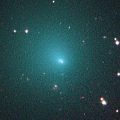
|
Now it is very bright as 10.4 mag (Nov. 18, Chris Wyatt). It stays 10 mag until November. In the Northern Hemisphere, it becomes unobservable soon. In the Southern Hemisphere, it becomes unobservable temporarily from December to January.
Date(TT) R.A. (2000) Decl. Delta r Elong. m1 Best Time(A, h)
Nov. 19 19 45.15 -40 16.9 1.912 1.600 56 10.5 18:20 ( 28, 7)
Nov. 26 19 38.62 -39 44.3 2.060 1.595 48 10.7 18:18 ( 33, 5)
|
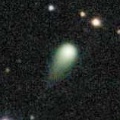
|
Now it is 11.3 mag (Nov. 18, Osamu Miyazaki). It stays bright as 10 mag for a long time until 2023 autumn. In the Northern Hemisphere, it stays observable in good condition until 2023 autumn. In the Southern Hemipshere, it stays unobservable until 2023 summer.
Date(TT) R.A. (2000) Decl. Delta r Elong. m1 Best Time(A, h)
Nov. 19 11 13.02 67 27.7 2.615 2.937 99 10.8 5:10 (200, 53)
Nov. 26 11 11.50 70 59.4 2.480 2.889 104 10.6 5:15 (193, 52)
|
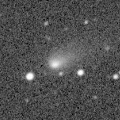
|
Now it is 11.5 mag (Nov. 18, Osamu Miyazaki). Appearing in the morning sky also in the Southern Hemisphere. It stays 11-12 mag until spring.
Date(TT) R.A. (2000) Decl. Delta r Elong. m1 Best Time(A, h)
Nov. 19 12 33.22 -2 24.7 2.110 1.620 47 11.6 5:10 (295, 28)
Nov. 26 12 52.52 -4 15.7 2.063 1.610 49 11.5 5:15 (300, 29)
|
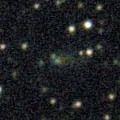
|
Now it is 13.8 mag (Nov. 5, Ken-ichi Kadota). It stays bright as 11-12 mag until January, and it is observable in excellent condition. It is a bit fainter than this ephemeris.
Date(TT) R.A. (2000) Decl. Delta r Elong. m1 Best Time(A, h)
Nov. 19 8 20.21 8 8.1 1.232 1.830 110 11.7 4:29 ( 0, 63)
Nov. 26 8 28.16 7 44.7 1.173 1.829 115 11.6 4:10 ( 0, 63)
|

|
It brightened up to 8.3 mag in last winter (Jan. 6, Toshiyuki Takahashi). Now it is fading. But it is bright as 11.5 mag still now (Nov. 18, Osamu Miyazaki).
Date(TT) R.A. (2000) Decl. Delta r Elong. m1 Best Time(A, h)
Nov. 19 9 58.18 -22 5.7 4.625 4.523 77 11.7 5:10 (344, 31)
Nov. 26 9 59.66 -23 37.1 4.573 4.560 83 11.7 5:15 (353, 31)
|

|
Now it is 13.4 mag (Nov. 12, Thomas Lehmann). It is expected to brighten up to 11 mag in 2023. In the Northern Hemisphere, it will be unobservable in November. In the Southern Hemisphere, it stays observable in good condition for a long time, although it becomes unobservable temporarily from November to January.
Date(TT) R.A. (2000) Decl. Delta r Elong. m1 Best Time(A, h)
Nov. 19 17 43.94 -18 3.8 4.311 3.493 30 12.2 18:20 ( 62, 7)
Nov. 26 17 49.80 -19 18.0 4.335 3.462 24 12.2 18:18 ( 64, 3)
|

|
Now it is 14.3 mag (Nov. 18, Toshihiko Ikemura, Hirohisa Sato). It stays bright as 12 mag until next summer. In the Northern Hemisphere, it stays observable in good condition until 2023 spring. In the Southern Hemisphere, it stays observable in good condition for a long time after this. It is fainter than this ephemeris recently.
Date(TT) R.A. (2000) Decl. Delta r Elong. m1 Best Time(A, h)
Nov. 19 4 38.31 17 16.9 1.818 2.785 165 12.7 0:49 ( 0, 72)
Nov. 26 4 27.19 13 58.2 1.752 2.732 171 12.6 0:10 ( 0, 69)
|
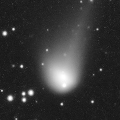
|
Now it is bright as 12.8 mag (Aug. 28, Hiroshi Abe). It stays 12 mag for a while. It becomes unobservable from August to November in the Northern Hemisphere, or from September to December in the Southern Hemisphere.
Date(TT) R.A. (2000) Decl. Delta r Elong. m1 Best Time(A, h)
Nov. 19 14 23.96 -2 47.6 5.336 4.453 24 12.8 5:10 (278, 6)
Nov. 26 14 31.41 -2 36.6 5.305 4.470 29 12.8 5:15 (281, 11)
|
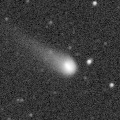
|
Now it is 13.7 mag (Sept. 24, Hiroshi Abe). It is expected to brighten up to 12 mag in 2023. In the Northern Hemisphere, it stays observable in good condition for a long time, although it became unobservable temporarily in October. In the Southern Hemisphere, it is not observable until mid December. But it will be observable in good condition in 2023.
Date(TT) R.A. (2000) Decl. Delta r Elong. m1 Best Time(A, h)
Nov. 19 13 48.05 8 30.1 4.535 3.811 38 13.2 5:10 (273, 20)
Nov. 26 13 49.81 7 36.1 4.443 3.792 43 13.1 5:15 (279, 26)
|
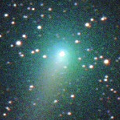
|
It brightened up to 9.3 mag in early summer (June 5, Chris Wyatt). Now it is fading. It has already faded down to 14.6 mag (Oct. 29, Chris Wyatt). In the Southen Hemisphere, it stays observable in good condition for a long time. It became observable also in the Northern Hemisphere. But it stays locating low for a while.
Date(TT) R.A. (2000) Decl. Delta r Elong. m1 Best Time(A, h)
Nov. 19 9 55.45 -42 53.4 2.767 2.661 73 13.4 5:10 (350, 11)
Nov. 26 9 46.97 -43 24.3 2.731 2.722 79 13.6 5:15 (358, 11)
|

|
Now it is 13.8 mag (Nov. 18. Toshihiko Ikemura, Hirohisa Sato).
Date(TT) R.A. (2000) Decl. Delta r Elong. m1 Best Time(A, h)
Nov. 19 6 56.48 29 15.0 5.320 6.044 133 13.5 3:06 ( 0, 84)
Nov. 26 6 54.36 29 19.1 5.247 6.046 141 13.5 2:37 ( 0, 84)
|
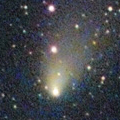
|
It brightened up to 10.4 mag from June to July (July 22, Ken-ichi Kadota). Appearing in the morning sky in the Souther Hemisphere. It will never be observable again in the Northern Hemisphere.
Date(TT) R.A. (2000) Decl. Delta r Elong. m1 Best Time(A, h)
Nov. 19 14 58.25 -56 55.1 2.705 2.024 38 13.5 5:10 (322,-28)
Nov. 26 15 27.11 -59 7.6 2.780 2.105 38 13.7 5:15 (324,-29)
|
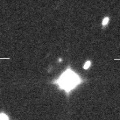
|
Now it is 14.3 mag (Nov. 10, C. Gerhard). It is expected to brighten up to 12.5 mag in winter. In the Northern Hemisphere, it will be observable in good condition after this. In the Southern Hemisphere, it is not observable until 2023 June.
Date(TT) R.A. (2000) Decl. Delta r Elong. m1 Best Time(A, h)
Nov. 19 13 10.67 26 29.4 2.446 2.094 57 14.2 5:10 (261, 36)
Nov. 26 13 26.15 28 54.6 2.299 2.046 62 13.9 5:15 (260, 41)
|
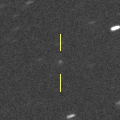
|
It will brighten up to 13 mag in winter. But the condition is bad. It is not observable until February in the Southern Hemisphere, or until May in the Northern Hemisphere.
Date(TT) R.A. (2000) Decl. Delta r Elong. m1 Best Time(A, h)
Nov. 19 15 24.11 -17 45.5 2.689 1.703 3 14.5 5:10 (282,-15)
Nov. 26 15 43.96 -19 18.0 2.661 1.681 5 14.4 5:15 (285,-13)
|
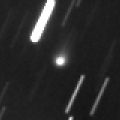
|
Now it is 14.5 mag (Oct. 29, Chris Wyatt). It stays 14 mag in 2023. In the Southern Hemisphere, it stays observable in good condition for a long time. It locates somewhat low in the Northern Hemisphere.
Date(TT) R.A. (2000) Decl. Delta r Elong. m1 Best Time(A, h)
Nov. 19 5 26.15 -23 39.7 2.990 3.697 129 14.6 1:36 ( 0, 31)
Nov. 26 5 9.78 -24 13.7 2.928 3.666 132 14.5 0:53 ( 0, 31)
|

|
Now it is 14.9 mag (Nov. 6, ATLAS Chile). It stays observable at 13-14 mag for a while. It locates low in the Northern Hemisphere.
Date(TT) R.A. (2000) Decl. Delta r Elong. m1 Best Time(A, h)
Nov. 19 19 46.85 -28 30.7 3.530 3.111 57 14.6 18:20 ( 33, 18)
Nov. 26 19 57.20 -27 58.6 3.615 3.119 52 14.7 18:18 ( 36, 17)
|

|
Now it is 15.1 mag (Oct. 26, Thomas Lehmann). The brightness evolution is slower than originally expected. It stays 14-15 mag for a long time. Now it is not observable. It will be observable in early January in the Northern Hemisphere, or in early February in the Southern Hemisphere.
Date(TT) R.A. (2000) Decl. Delta r Elong. m1 Best Time(A, h)
Nov. 19 17 13.01 -19 26.6 3.910 3.024 22 14.8 18:20 ( 66, 1)
Nov. 26 17 18.04 -18 18.0 3.967 3.039 17 14.9 18:18 ( 69, -3)
|
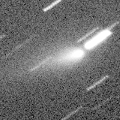
|
Outburst occured in early October. Now it is very bright as 11.0 mag (Nov. 12, Thomas Lehmann). It stays observable in good condition in the Southern Hemisphere. It locates low in the Northern Hemisphere. Michael Jager detected several fragments at 17.5-19 mag.
Date(TT) R.A. (2000) Decl. Delta r Elong. m1 Best Time(A, h)
Nov. 19 21 9.95 -28 36.1 1.409 1.503 75 14.9 18:20 ( 15, 25)
Nov. 26 21 34.73 -26 14.5 1.512 1.567 74 15.3 18:18 ( 16, 27)
|
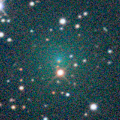
|
Brightening very rapidly. Now it is 14.5 mag (Nov. 17, Michael Jager). It brightens up to 13 mag in January. In the Northern Hemisphere, it stays observable in excellent condition. In the Southern Hemisphere, it is not observable until February.
Date(TT) R.A. (2000) Decl. Delta r Elong. m1 Best Time(A, h)
Nov. 19 18 53.31 67 18.9 1.141 1.559 93 15.2 18:20 (154, 47)
Nov. 26 18 56.00 67 22.3 1.081 1.509 93 15.0 18:18 (153, 45)
|
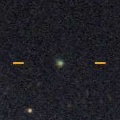
|
Now it is 15.5 mag (Nov. 14, Thomas Lehmann). It is expected to brighten up to 8 mag in 2023 July. In 2022, it stays observable in good condition while the comet will be brightening gradually.
Date(TT) R.A. (2000) Decl. Delta r Elong. m1 Best Time(A, h)
Nov. 19 1 38.10 -10 28.8 2.728 3.529 138 15.2 21:44 ( 0, 45)
Nov. 26 1 25.15 -11 30.1 2.752 3.459 129 15.1 21:03 ( 0, 44)
|
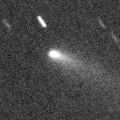
|
Now it is 14.8 mag (Oct. 25, Michael Jager). It stays 15 mag and observable in excellent condition until December.
Date(TT) R.A. (2000) Decl. Delta r Elong. m1 Best Time(A, h)
Nov. 19 2 10.17 23 56.2 1.475 2.426 159 15.2 22:16 ( 0, 79)
Nov. 26 2 5.17 24 39.9 1.515 2.431 152 15.3 21:44 ( 0, 80)
|
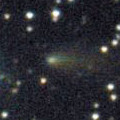
|
Now it is 15.2 mag (Nov. 18, Toshihiko Ikemura, Hirohisa Sato). It stays observable in good condition at 15 mag from summer to winter. It locates somwwhat low in the Southern Hemisphere.
Date(TT) R.A. (2000) Decl. Delta r Elong. m1 Best Time(A, h)
Nov. 19 8 5.49 19 10.7 1.815 2.427 116 15.2 4:15 ( 0, 74)
Nov. 26 8 7.82 19 23.9 1.754 2.441 123 15.2 3:50 ( 0, 74)
|
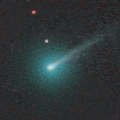
|
It brightened rapidly up to 12.4 mag in early October (Oct. 2, Michael Jager). Then it became fainter a bit, 13.6 mag (Oct. 30, Ken-ichi Kadota). Although it is a tiny comet, it approached to Sun down to 0.63 a.u. on Oct. 25. It is not observable after this.
Date(TT) R.A. (2000) Decl. Delta r Elong. m1 Best Time(A, h)
Nov. 19 15 10.38 -1 23.8 1.689 0.820 18 15.3 5:10 (270, -3)
Nov. 26 15 31.70 -5 36.5 1.809 0.915 17 15.9 5:15 (275, -3)
|

|
Now it is 14.8 mag (Oct. 29, Chris Wyatt). It was expected to brighten up to 13 mag in spring. But actually, it was fainter than originally expected. In the Southern Hemisphere, it stays observable in good condition for a long time. In the Northern Hemisphere, it stays extremely low for a while.
Date(TT) R.A. (2000) Decl. Delta r Elong. m1 Best Time(A, h)
Nov. 19 4 8.90 -53 2.4 3.042 3.466 107 15.4 0:20 ( 0, 2)
Nov. 26 3 47.09 -51 54.5 3.074 3.495 107 15.5 23:23 ( 0, 3)
|
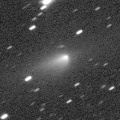
|
It brightened up to 12.7 mag in early 2022 (Feb. 27, Toshihiko Ikemura, Hirohisa Sato). Now it is fading. Now it is not observable. It will be observable agin at 16 mag in January in the Southern Hemisphere, or in February in the Northern Hemisphere.
Date(TT) R.A. (2000) Decl. Delta r Elong. m1 Best Time(A, h)
Nov. 19 15 34.76 -20 46.4 3.350 2.362 1 15.5 5:10 (283,-19)
Nov. 26 15 49.64 -21 39.4 3.364 2.380 3 15.5 5:15 (286,-15)
|
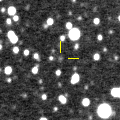
|
Now it is 15.9 mag (Nov. 5, Ken-ichi Kadota). It will brighten up to 13 mag from 2024 to 2025.
Date(TT) R.A. (2000) Decl. Delta r Elong. m1 Best Time(A, h)
Nov. 19 9 12.88 -34 22.4 7.038 7.000 83 15.7 5:10 (357, 20)
Nov. 26 9 14.03 -35 9.0 6.929 6.965 88 15.7 4:55 ( 0, 20)
|
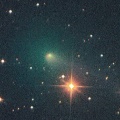
|
Now it is 14.8 mag (Oct. 20, Toshihiko Ikemura, Hirohisa Sato). It stays observable in good condition after this. But it will be fading gradually after this.
Date(TT) R.A. (2000) Decl. Delta r Elong. m1 Best Time(A, h)
Nov. 19 0 46.76 -2 10.5 1.925 2.700 133 15.8 20:53 ( 0, 53)
Nov. 26 0 46.36 -1 55.9 2.040 2.741 126 16.0 20:26 ( 0, 53)
|
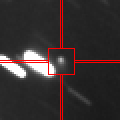
|
Now it is 15.7 mag (Nov. 2, Ken-ichi Kadota). It is expected to brighten up to 7 mag in early 2024. In the Southern Hemisphere, it stays observable in good condition for a long time. In the Northern Hemisphere, it stays low in 2022.
Date(TT) R.A. (2000) Decl. Delta r Elong. m1 Best Time(A, h)
Nov. 19 6 13.21 -35 2.4 4.992 5.470 114 15.9 2:23 ( 0, 20)
Nov. 26 6 9.48 -35 57.6 4.900 5.407 116 15.8 1:51 ( 0, 19)
|
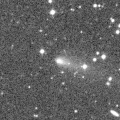
|
Now it is 15.1 mag (Nov. 14, Thomas Lehmann). It stays 15 mag until November, and it stays observable in good condition.
Date(TT) R.A. (2000) Decl. Delta r Elong. m1 Best Time(A, h)
Nov. 19 1 16.24 -0 25.6 1.278 2.135 140 15.8 21:23 ( 0, 55)
Nov. 26 1 17.02 -0 17.3 1.336 2.141 133 15.9 20:56 ( 0, 55)
|
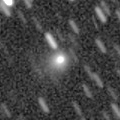
|
It brightened by 6 mag in outburst in early August up to 14.6 mag (Aug. 13, ATLAS-MLO, Mauna Loa). It is bright as 16.2 mag still now (Nov. 18, Toshihiko Ikemura, Hirohisa Sato). It seems to stay 16 mag for a while. It stays observable in good condition for a while.
Date(TT) R.A. (2000) Decl. Delta r Elong. m1 Best Time(A, h)
Nov. 19 20 20.03 -7 17.7 1.894 1.807 69 16.0 18:20 ( 38, 40)
Nov. 26 20 36.87 -7 54.9 1.933 1.787 66 16.0 18:18 ( 40, 39)
|
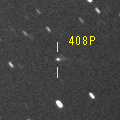
|
Now it is 16.3 mag (Nov. 7, ATLAS-MLO, Mauna Loa). It will be observable at 16-17 mag in excellent condition from autumn to winter.
Date(TT) R.A. (2000) Decl. Delta r Elong. m1 Best Time(A, h)
Nov. 19 4 25.21 -0 11.1 2.543 3.474 157 16.0 0:35 ( 0, 55)
Nov. 26 4 20.99 -0 44.6 2.541 3.476 158 16.1 0:04 ( 0, 54)
|
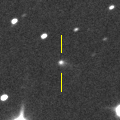
|
Now it is 15.6 mag (Nov. 18, Toshihiko Ikemura, Hirohisa Sato). It stays 16 mag and observable in good condition until spring.
Date(TT) R.A. (2000) Decl. Delta r Elong. m1 Best Time(A, h)
Nov. 19 9 17.91 16 51.0 3.151 3.456 99 16.1 5:10 (347, 71)
Nov. 26 9 22.96 17 7.6 3.043 3.443 105 16.1 5:05 ( 0, 72)
|

|
It was observed at 15 mag from 2021 to 2022. Now it is fading. In the Southern Hemisphere, it stays observable in excellent condition for a long time, although it became extremely low temporarily in November. In the Northern Hemiphere, it is not observable after this.
Date(TT) R.A. (2000) Decl. Delta r Elong. m1 Best Time(A, h)
Nov. 19 14 54.75 -53 40.6 6.551 5.772 35 16.2 5:10 (319,-27)
Nov. 26 14 58.68 -54 29.4 6.568 5.798 35 16.2 5:15 (321,-23)
|
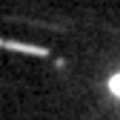
|
Now it is 17.3 mag (Nov. 10, J. Nicolas, J.-G. Bosch, F. Kugel). It will brighten rapidly up to 14 mag in spring. In the Southern Hemisphere, it will appear in the morning sky in December, and it will be observable in excellent condition in spring. In the Northern Hemisphere, it is observable in good condition in winter, but it becomes somewhat low in spring.
Date(TT) R.A. (2000) Decl. Delta r Elong. m1 Best Time(A, h)
Nov. 19 12 46.81 3 39.7 3.069 2.510 47 16.4 5:10 (288, 29)
Nov. 26 12 57.07 2 4.7 2.987 2.494 51 16.3 5:15 (293, 33)
|
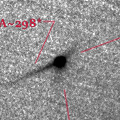
|
Due to the DART spacecraft impact to its satellite Dimorphos on Sept. 26, the cometary activity was detected. It brightened up to 12.9 mag (Sept. 28, John Drummond). It is fading after that. It has already faded down to 15.9 mag (Oct. 29, Katsumi Yoshimoto). It stays observable in good condition for a while.
Date(TT) R.A. (2000) Decl. Delta r Elong. m1 Best Time(A, h)
Nov. 19 8 19.04 15 37.9 0.149 1.055 112 16.4 4:28 ( 0, 70)
Nov. 26 8 22.82 18 34.7 0.163 1.077 119 16.5 4:05 ( 0, 73)
|
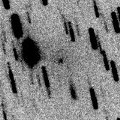
|
Now it is 17.6 mag (Oct. 25, Michael Jager). Tiny comet, but it will approach to Sun down to 0.8 a.u. in January, and to Earth down to 0.6 a.u. in March. It will brighten up to 14 mag from January to March. In the Southern Hemisphere, it stays observable in good condition for a long time. In the Northern Hemisphere, it is observable only until early Decemebr. Then it will become observable again in early March.
Date(TT) R.A. (2000) Decl. Delta r Elong. m1 Best Time(A, h)
Nov. 19 20 15.04 -28 9.3 1.532 1.407 63 16.9 18:20 ( 28, 21)
Nov. 26 20 20.11 -31 20.7 1.553 1.316 57 16.6 18:18 ( 30, 16)
|
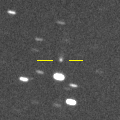
|
Now it is 17.7 mag (July 9, ATLAS Chile). It will brighten up to 16 mag in 2023. In the Southern Hemisphere, it stays observable in good condition for a long time, although it became low temporarily from August to October. In the Northern Hemisphere, it will never be observable again.
Date(TT) R.A. (2000) Decl. Delta r Elong. m1 Best Time(A, h)
Nov. 19 12 58.24 -47 49.8 3.997 3.339 42 16.7 5:10 (324, -8)
Nov. 26 13 11.58 -49 53.0 3.950 3.324 44 16.7 5:15 (328, -8)
|

|
Now it is 19.8 mag (Oct. 7, J. L. Virlichie, P. Traverse, H. Roy, G. Houdin). It will approach to Sun down to 0.1 a.u. on Jan. 31. In the Northern Hemisphere, it will appear in the morning sky at 9 mag in mid February, then it stays observable while the comet will be fading. In the Southern Hemisphere, it stays observable for a long time, although it is not observable from mid January to mid February.
Date(TT) R.A. (2000) Decl. Delta r Elong. m1 Best Time(A, h)
Nov. 19 18 19.52 -47 36.4 2.261 1.687 43 17.2 18:20 ( 35, -8)
Nov. 26 18 31.14 -47 0.1 2.212 1.579 39 16.8 18:18 ( 37, -9)
|
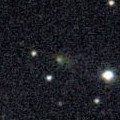
|
Now it is 16.4 mag (Nov. 5, Hirohisa Sato). It will be observable at 16-17 mag in good condition from summer to autumn.
Date(TT) R.A. (2000) Decl. Delta r Elong. m1 Best Time(A, h)
Nov. 19 3 10.68 25 35.1 1.635 2.617 171 16.8 23:17 ( 0, 81)
Nov. 26 3 5.19 24 56.1 1.678 2.645 165 16.9 22:44 ( 0, 80)
|
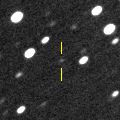
|
Now it is 17.3 mag (Oct. 30, ATLAS Chile). It is expected to brighten up to 12-13 mag from 2024 to 2025.
Date(TT) R.A. (2000) Decl. Delta r Elong. m1 Best Time(A, h)
Nov. 19 10 34.48 -19 29.3 6.938 6.672 70 16.9 5:10 (334, 31)
Nov. 26 10 34.14 -19 41.4 6.785 6.628 76 16.9 5:15 (343, 33)
|
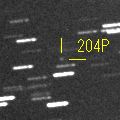
|
Now it is 17.7 mag (Nov. 10, ATLAS-HKO, Haleakala). It will brighten rapidly, and it will be observable at 16 mag in good condition in winter.
Date(TT) R.A. (2000) Decl. Delta r Elong. m1 Best Time(A, h)
Nov. 19 9 23.09 14 58.3 1.416 1.834 97 17.1 5:10 (344, 69)
Nov. 26 9 34.79 14 34.4 1.355 1.836 102 17.0 5:15 (359, 69)
|

|
It brightened up to 14 mag in 2021. Now it is fading. It has already faded down to 16.8 mag (Nov. 1, Thomas Lehmann). It is observable at 16-17 mag in 2022.
Date(TT) R.A. (2000) Decl. Delta r Elong. m1 Best Time(A, h)
Nov. 19 23 16.89 15 0.4 5.937 6.465 118 17.0 19:24 ( 0, 70)
Nov. 26 23 16.24 15 1.4 6.076 6.503 111 17.0 18:56 ( 0, 70)
|
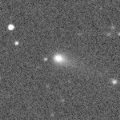
|
Now it is 16.6 mag (Oct. 26, ATLAS-MLO, Mauna Loa). It continued brightening even after the perihelion passage. It stays observable at 16 mag in good condition for a while.
Date(TT) R.A. (2000) Decl. Delta r Elong. m1 Best Time(A, h)
Nov. 19 22 59.02 -3 39.0 3.985 4.395 108 17.0 19:06 ( 0, 51)
Nov. 26 23 1.07 -3 32.9 4.102 4.408 101 17.1 18:41 ( 0, 52)
|

|
It brightened very rapidly up to 15.5 mag from last autumn to last winter (Nov. 2, 2021, Toshihiko Ikemura, Hirohisa Sato). Now it is fading slowly. It has already faded down to 16.3 mag (Nov. 18, Toshihiko Ikemura, Hirohisa Sato).
Date(TT) R.A. (2000) Decl. Delta r Elong. m1 Best Time(A, h)
Nov. 19 6 47.43 10 40.4 3.622 4.358 133 17.1 2:57 ( 0, 66)
Nov. 26 6 45.31 10 20.3 3.572 4.376 140 17.1 2:28 ( 0, 65)
|
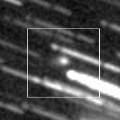
|
Now it is 16.8 mag (Nov. 8, Ken-ichi Kadota). It is expected to brighten up to 11-12 mag in 2024. In the Northern Hemisphere, it stays observable in good condition for a long time until 2023 autumn, although it becomes temporarily low in December. In the Southern Hemisphere, it is not observable until February. But it will be observable in excellent condition at the high light.
Date(TT) R.A. (2000) Decl. Delta r Elong. m1 Best Time(A, h)
Nov. 19 18 0.91 17 35.5 5.914 5.351 51 17.1 18:20 ( 90, 32)
Nov. 26 18 3.15 16 54.9 5.916 5.299 47 17.1 18:18 ( 93, 27)
|

|
Now it is 16.0 mag (Oct. 27, ATLAS South Africa). It brightened up to 14 mag from 2020 to 2021. Now it is fading slowly. It is observable at 16-17 mag in 2022.
Date(TT) R.A. (2000) Decl. Delta r Elong. m1 Best Time(A, h)
Nov. 19 0 4.53 -18 45.4 3.572 4.098 115 17.2 20:11 ( 0, 36)
Nov. 26 0 4.23 -18 10.9 3.683 4.115 109 17.2 19:44 ( 0, 37)
|
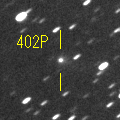
|
It brightened up to 15.3 mag in last winter (Jan. 12, H. Nohara). Now it is fading. It has already faded down to 17.4 mag (Nov. 5, Ken-ichi Kadota). It will be observable at 17 mag in good condition in next winter. It locates low in the Southern Hemisphere.
Date(TT) R.A. (2000) Decl. Delta r Elong. m1 Best Time(A, h)
Nov. 19 10 14.62 18 55.2 4.304 4.375 87 17.2 5:10 (310, 67)
Nov. 26 10 18.22 19 16.5 4.213 4.392 93 17.2 5:15 (325, 71)
|

|
Now it is 17.0 mag (Nov. 9, A. Diepvens). Fading slowly. In the Northern Hemisphere, it stays observable in good condition for a long time. In the Southern Hemisphere, it is not observable after this.
Date(TT) R.A. (2000) Decl. Delta r Elong. m1 Best Time(A, h)
Nov. 19 17 26.20 62 42.4 9.555 9.517 84 17.2 18:20 (146, 39)
Nov. 26 17 30.42 62 41.3 9.564 9.532 85 17.2 18:18 (146, 36)
|

|
It brightened up to 14.2 mag in 2021 summer (July 18, 2021, Taras Prystavski). Now it is fading. It has already faded down to 16.7 mag (Oct. 31, ATLAS South Africa). In the Southern Hemisphere, it stays observable in good condition for a long time. It locates somewhat low in the Northern Hemisphere.
Date(TT) R.A. (2000) Decl. Delta r Elong. m1 Best Time(A, h)
Nov. 19 1 24.12 -24 22.4 5.082 5.717 125 17.3 21:30 ( 0, 31)
Nov. 26 1 20.89 -23 36.9 5.201 5.760 120 17.4 21:00 ( 0, 32)
|
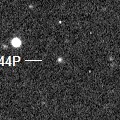
|
Now it is 17.4 mag (Nov. 18, Toshihiko Ikemura, Hirohisa Sato). It is observable at 17 mag in good condition in winter. It locates somewhat low in the Southern Hemisphere.
Date(TT) R.A. (2000) Decl. Delta r Elong. m1 Best Time(A, h)
Nov. 19 6 30.11 26 6.1 3.116 3.920 139 17.4 2:40 ( 0, 81)
Nov. 26 6 27.41 26 11.1 3.055 3.921 147 17.3 2:10 ( 0, 81)
|
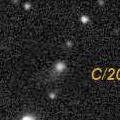
|
It stays 17 mag and observable in good condition for a long time until 2023 summer.
Date(TT) R.A. (2000) Decl. Delta r Elong. m1 Best Time(A, h)
Nov. 19 13 33.13 3 31.6 9.607 8.848 37 17.3 5:10 (280, 20)
Nov. 26 13 34.20 3 35.8 9.529 8.851 44 17.3 5:15 (285, 26)
|
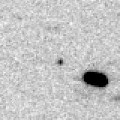
|
Now it is 17.0 mag (Nov. 18, Toshihiko Ikemura, Hirohisa Sato). It stays observable at 16 mag for a long time from early 2023 to early 2024. In the Northern Hemisphere, it is observable only until 2023 spring.
Date(TT) R.A. (2000) Decl. Delta r Elong. m1 Best Time(A, h)
Nov. 19 10 34.28 6 41.9 4.700 4.608 78 17.5 5:10 (317, 54)
Nov. 26 10 34.06 5 41.8 4.546 4.573 85 17.4 5:15 (331, 57)
|
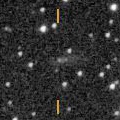
|
Now it is 17.6 mag (Nov. 2, ATLAS-MLO, Mauna Loa). In the Northern Hemisphere, it stays observable at 17 mag in good condition for a long time until winter. In the Southern Hemisphere, it stays extremely low for a long time.
Date(TT) R.A. (2000) Decl. Delta r Elong. m1 Best Time(A, h)
Nov. 19 8 14.91 49 4.2 2.356 2.948 117 17.4 4:25 (180, 76)
Nov. 26 8 17.55 49 33.2 2.316 2.972 123 17.4 4:00 (180, 76)
|
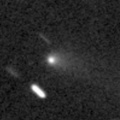
|
Now it is 17.7 mag (Oct. 30, ATLAS Chile). Now it is fading. It stays 13-14 mag for a while. It is observable in excellent condition in the Southern Hemisphere. It locates somewhat low in the Northern Hemisphere.
Date(TT) R.A. (2000) Decl. Delta r Elong. m1 Best Time(A, h)
Nov. 19 22 33.65 -21 15.3 2.415 2.698 95 17.4 18:41 ( 0, 34)
Nov. 26 22 39.39 -20 9.3 2.546 2.737 90 17.6 18:19 ( 0, 35)
|
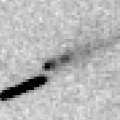
|
It brightened up to 16.1 mag in autumn (Sept. 23, Michael Jager). Then it is fading very rapidly. It has already faded down to 17.9 mag (Oct. 28, Ken-ichi Kadota). It will be getting higher after this also in the Southern Hemisphere.
Date(TT) R.A. (2000) Decl. Delta r Elong. m1 Best Time(A, h)
Nov. 19 10 31.83 5 18.5 1.619 1.724 78 17.4 5:10 (320, 54)
Nov. 26 10 42.49 3 12.4 1.583 1.753 82 17.4 5:15 (330, 54)
|
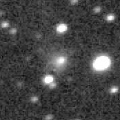
|
Now it is 17.3 mag (Oct. 19, Toshihiko Ikemura, Hirohisa Sato). It stayed bright for a while even after the perihelion passage, but it will be fading after this. It will be fainter than 18 mag in winter.
Date(TT) R.A. (2000) Decl. Delta r Elong. m1 Best Time(A, h)
Nov. 19 21 13.46 -2 6.6 7.391 7.354 83 17.4 18:20 ( 24, 50)
Nov. 26 21 14.07 -2 40.0 7.540 7.381 77 17.5 18:18 ( 32, 48)
|
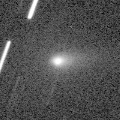
|
It brightened rapidly as predicted, and it brightened up to 14.0 mag in September (Sept. 22, Michael Jager). Now it is fading. It has already faded down to 16.6 mag (Nov. 10, ATLAS Chile). It will be fainter than 18 mag in December.
Date(TT) R.A. (2000) Decl. Delta r Elong. m1 Best Time(A, h)
Nov. 19 2 15.40 -40 0.9 1.049 1.744 117 17.4 22:22 ( 0, 15)
Nov. 26 2 16.73 -39 34.8 1.124 1.776 114 17.7 21:56 ( 0, 16)
|
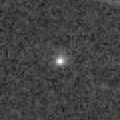
|
Now it is 16.8 mag (Nov. 18, Toshihiko Ikemura, Hirohisa Sato). It stays observable at 17-18 mag until next summer. It may be brighter than this ephemeris.
Date(TT) R.A. (2000) Decl. Delta r Elong. m1 Best Time(A, h)
Nov. 19 21 34.11 -14 9.2 1.710 1.898 84 17.4 18:20 ( 13, 40)
Nov. 26 21 21.08 -13 27.3 1.846 1.856 75 17.5 18:18 ( 24, 38)
|

|
Now it is 17.8 mag (Oct. 30, Catalina Sky Survey). It stays observable at 17-18 mag in 2022. It locates somewhat low in the Southern Hemisphere.
Date(TT) R.A. (2000) Decl. Delta r Elong. m1 Best Time(A, h)
Nov. 19 0 48.07 21 37.1 4.807 5.607 140 17.6 20:54 ( 0, 77)
Nov. 26 0 41.24 20 35.6 4.909 5.623 132 17.7 20:20 ( 0, 76)
|
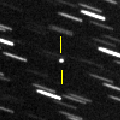
|
It approached to Sun down to 0.14 a.u. on May 15. But it was not observable around that time. In the Northern Hemisphere, it stays observable at 17-18 mag in good condition from July to November. In the Southern Hemisphere, it stays extremely low.
Date(TT) R.A. (2000) Decl. Delta r Elong. m1 Best Time(A, h)
Nov. 19 1 17.80 36 10.0 1.392 2.276 145 17.6 21:24 (180, 89)
Nov. 26 1 7.27 33 39.1 1.463 2.299 138 17.8 20:46 ( 0, 89)
|

|
It brightened up to 12.3 mag from spring to summer in 2021 (June 15, 2021, Marco Goiato). Now it is fading. It will be fainter than 18 mag in January. Recently it is observed extremely faint as 20.8 mag (Oct. 27, Q.-Z. Ye, M. S. P. Kelley).
Date(TT) R.A. (2000) Decl. Delta r Elong. m1 Best Time(A, h)
Nov. 19 12 41.32 30 33.4 6.434 6.086 65 17.6 5:10 (259, 44)
Nov. 26 12 42.84 31 11.8 6.379 6.133 71 17.7 5:15 (262, 51)
|
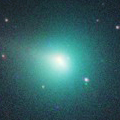
|
It brightened up to 8.8 mag from last winter to early spring (Jan. 31, Chris Wyatt). Now it is fading. Appearing in the morning sky. It will be fainter than 18 mag in December.
Date(TT) R.A. (2000) Decl. Delta r Elong. m1 Best Time(A, h)
Nov. 19 13 48.20 12 31.6 3.777 3.106 41 17.7 5:10 (270, 22)
Nov. 26 13 56.57 11 58.5 3.762 3.151 45 17.8 5:15 (274, 27)
|
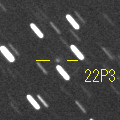
|
Now it is 17.7 mag (Nov. 18, Toshihiko Ikemura, Hirohisa Sato). In the Northern Hemisphere, it is observable at 17-18 mag in excellent condition in autumn. It is not observable in the Southern Hemisphere.
Date(TT) R.A. (2000) Decl. Delta r Elong. m1 Best Time(A, h)
Nov. 19 8 25.46 60 23.2 2.266 2.835 115 17.8 4:35 (180, 65)
Nov. 26 8 30.10 63 25.9 2.253 2.867 119 17.8 4:13 (180, 62)
|
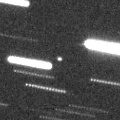
|
Now it is 17.4 mag (Oct. 23, Toshihiko Ikemura, Hirohisa Sato). In 2022, it stays observable at 17 mag for a long time.
Date(TT) R.A. (2000) Decl. Delta r Elong. m1 Best Time(A, h)
Nov. 19 8 26.68 19 15.7 0.785 1.475 111 17.9 4:36 ( 0, 74)
Nov. 26 8 23.62 19 3.8 0.784 1.535 119 17.8 4:06 ( 0, 74)
|
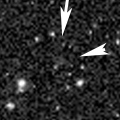
|
Now it is 17.4 mag (Oct. 28, ATLAS Chile). Very far object. It stays 18 mag for a long time from 2021 to 2026. In the Southern Hemisphere, it stays observable in good condition for a long time. In the Northern Hemisphere, it is not observable at all.
Date(TT) R.A. (2000) Decl. Delta r Elong. m1 Best Time(A, h)
Nov. 19 8 2.56 -73 24.8 10.656 10.492 77 17.8 4:11 ( 0,-18)
Nov. 26 7 54.56 -74 9.2 10.642 10.485 78 17.8 3:35 ( 0,-19)
|
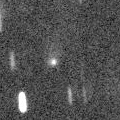
|
Now it is 17.9 mag (Oct. 19, Toshihiko Ikemura, Hirohisa Sato). It started fading before the perihelion passage. It was predicted to stay at 16 mag for a long time. But actually, it will be fainter than 18 mag soon. In the Northern Hemisphere, it stays observable in good condition for a long time. In the Southern Hemisphere, it is not observable until 2023.
Date(TT) R.A. (2000) Decl. Delta r Elong. m1 Best Time(A, h)
Nov. 19 18 24.92 36 54.4 4.419 4.166 68 17.9 18:20 (110, 45)
Nov. 26 18 32.14 35 12.6 4.497 4.193 65 18.0 18:18 (109, 40)
|
|
![]()
 44P/Reinmuth 2
44P/Reinmuth 2 C/2022 E2 ( ATLAS )
C/2022 E2 ( ATLAS ) 204P/LINEAR-NEAT
204P/LINEAR-NEAT C/2020 F5 ( MASTER )
C/2020 F5 ( MASTER ) 395P/2020 H1 ( Catalina-NEAT )
395P/2020 H1 ( Catalina-NEAT ) P/2021 N2 ( Fuls )
P/2021 N2 ( Fuls ) C/2022 L2 ( ATLAS )
C/2022 L2 ( ATLAS ) 246P/NEAT
246P/NEAT 402P/2020 Q3 ( LINEAR )
402P/2020 Q3 ( LINEAR ) C/2019 O3 ( Palomar )
C/2019 O3 ( Palomar ) C/2019 F1 ( ATLAS-Africano )
C/2019 F1 ( ATLAS-Africano ) 244P/Scotti
244P/Scotti C/2020 F2 ( ATLAS )
C/2020 F2 ( ATLAS ) C/2022 A3 ( Lemmon-ATLAS )
C/2022 A3 ( Lemmon-ATLAS ) C/2021 QM45 ( PanSTARRS )
C/2021 QM45 ( PanSTARRS ) 9P/Tempel 1
9P/Tempel 1 157P/Tritton
157P/Tritton C/2019 T3 ( ATLAS )
C/2019 T3 ( ATLAS ) 327P/Van Ness
327P/Van Ness C/2022 Q2 ( ATLAS )
C/2022 Q2 ( ATLAS ) C/2020 U4 ( PanSTARRS )
C/2020 U4 ( PanSTARRS ) (3200) Phaethon
(3200) Phaethon C/2020 J1 ( SONEAR )
C/2020 J1 ( SONEAR ) 19P/Borrelly
19P/Borrelly C/2022 P3 ( ZTF )
C/2022 P3 ( ZTF ) 107P/(4015) Wilson-Harrington
107P/(4015) Wilson-Harrington C/2019 E3 ( ATLAS )
C/2019 E3 ( ATLAS ) C/2020 U5 ( PanSTARRS )
C/2020 U5 ( PanSTARRS )![]()


































































